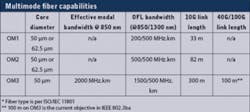An update on the current state of optical fiber in standards, including the definition of OM4.
Multimode optical fibers have always offered users the most cost-effective choice to achieve the benefits of fiber-optic transmission in premises applications. The simple reason is that the electronics are less expensive than those used to power singlemode fibers. While TR-42, the User Premises Telecommunications Cabling Requirements Engineering Committee, has recognized both multimode and singlemode optical fiber for private-network structured cabling, this was because a combined system has always provided the best value for the end user who might need single-mode fiber to support long distances or very high data rates.
The good news is that the newest generations of multimode fibers can support the same high data rates as singlemode, including 40 and 100 Gbits/sec, while retaining the cost savings associated with multimode fibers.
TR-42 initially recognized 62.5-µm multimode fiber in ANSI/TIA-568, The Commercial Building Cabling Standard. As newer applications and optical sources came along, the higher-bandwidth capabilities of 50-µm fiber became recognized as well. As transmission speeds increased, the market shifted from 62.5-µm to 50-µmfiber and, more recently, to 50-µm laser-optimized fiber (OM3). This trend will be accelerated with the advent of 40/100-Gigabit Ethernet (GbE) because there is no OM1 or OM2 objective at these next-generation speeds.
The next speed generations
The current objectives for both 40 and 100 GbE are to cover a distance of at least 100 meters on OM3 fiber. The 100-meter value will allow for extremely low-cost transceivers, but is well short of the 300-meter distance allowed by TR-42 in the TIA-942 data center standard; and no one seems excited about having to use singlemode electronics and singlemode fiber for every link in their network that reached farther than 100 meters.
In a survey presented at the Institute of Electrical and Electronics Engineers (IEEE; www.ieee.org) 802.3 meeting in July 2008, 20 diverse end users were asked to consider three options. (Note that OM4 is a higher-bandwidth multimode fiber that will be discussed in greater detail later in this article). The three options were:
A) OM3 to 100 meters (requires one optical module);
B) OM3 to 150 or 200 meters; OM4 to 250 meters(requires one optical module);
C) OM3 to 100 meters; OM3 to 150 or 200 meters; OM4 to 250 meters (requires two optical modules).
The survey results were overwhelmingly (16 or 20) in favor of Option B: OM3 to 150 or 200 meters and OM4 to 250 meters. A minority (4 of 20) favored Option C: OM3 to 100 meters. All survey participants believed the 100-meter transmission length limit suggested by 802.3 would increase the cost of data centers at 40/100-Gbit/sec speeds by forcing them to use a more expensive single-mode system to meet their link-length requirements.
An ad hoc subgroup within 802.3 is studyingextended reach, and working on extending the multimode distance from the current "at least 100 meters on OM3" to somewhere between 150 and 250 meters. Technical feasibility for these extended distances has been shown. What remains is to identify the distance and technical path that will provide the best, lowest-cost solution. The goal is to ensure that multimode fiber customers continue to get the best bang for their buck.
One possible path to achieve the extended distance would be through the use of a higher-bandwidth fiber. Unfortunately, the transceiver specifications that are currently proposed for the 40/100-GbE standards are such that a higher-bandwidth fiber, on its own, doesn't provide much benefit. The sources have such broad spectral widths that the effects of higher bandwidth may only extend the distance by a few percent. But a higher-bandwidth fiber, combined with tighter transceiver specifications or a chip added to the host board, could support link lengths of at least 250 meters on multimode fiber.
Developers of standards using the Fibre Channel (FC) protocol also have started talking about next-generation speeds. This set of standards increases speeds by a factor of 2 with each generation. Standards are currently in place for 8-Gbit FC, with discussions around creating a 16-Gbit standard on the horizon. In a Fibre Channel meeting last year, participants agreed that a multimode fiber with significantly higher bandwidth should be developed/characterized to support 16-Gbit/secserial transmission over 150 meters.
OM4 fiber standardization
Standardization activities of OM4 multimode fiber are active in two fiber standards groups: TIA and IEC (International Electrotechnical Commission; www.iec.ch). Both the IEEE 802.3 (Ethernet) and Fibre Channel application standards groups have expressed interest in a higher-data-rate multimode fiber above and beyond the performance currently offered by OM3 fiber. This has prompted the ISO/IEC premises wiring cable committee to request the development of a new high-data-rate multimode fiber standard.
OM3 and OM4 are referred to as "laser-optimized" multimode fibers because they are specifically designed for use with high-performance, low-cost vertical-cavity surface-emitting lasers (VCSELs). Careful processing to precisely control the fiber's refractive index profile is paramount to minimize modal dispersion—or, differential mode delay (DMD).
By limiting DMD, all modes (light paths) in the fiber arrive at the transceiver at the same time, minimizing pulse spreading and thus maximizing bandwidth. Bandwidth is ensured by thorough DMD testing after the fiber is manufactured. Thus, these higher-bandwidth fibers provide a combination of longer reach and lower system implementation cost for current (e.g., 10-Gbit/sec) and more importantly, future higher-data-rate multimode fiber systems.
Standardized in 2002, OM3 fiber has a minimum effective modal bandwidth (EMB) of 2,000 Mhz·km at 850 nm using VCSEL transceivers. This is sufficient bandwidth to operate a 10-Gbit/sec Ethernet system up to 300 meters. An OM4 fiber is expected to specify a minimum EMB of 4,700 MHz·km at 850 nm—more than twice the bandwidth of OM3.
OM3 fibers are backward-compatible and can support legacy applications that use LED transmitters operating at either 850 or 1,300 nm. There is a general consensus among the fiber manufacturers that OM4 will also be backward-compatible; however, the standard is still in the early stages of development and the exact specifications have not been finalized.
TIA standards committee TR-42.12, Optical Fibers and Cables, is developing the specification to be named TIA/EIA-492AAAD "Detail specification for OM4 850-nm laser-optimized, 50-µm core diameter/125-µm cladding diameter class 1a graded-index multimode optical fibers." This standard is scheduled to be ratified in mid-2009. In parallel, IEC SC 86A Working Group 1 initiated work on the OM4 fiber standardization in April 2008. The A1 MMF standard 60793-20-10 will be revised to include a higher grade A1a.3 (OM4) fiber.
Laser-optimized 50-µm fibers (OM3 and the future OM4) will support 10-Gbit/sec transmission over 300 to 550 meters. For 40- and 100-Gbit/sec transmission, they will support at least 100 meters, but efforts are underway to increase that distance to 150 to 250 meters. This longer distance would cover the majority of LAN and data center link-length requirements.
By enabling significantly lower-cost transceivers, multimode fiber systems continue to be the low-cost, future-ready solution for premises networks of yesterday, today, and tomorrow.
This article was developed on behalf of the Telecommunications Industry Association's Fiber Optics LAN Section (www.fols.org) by Sharon Bois, multimode fiber product line manager at Corning Optical Fiber; David Mazzarese, technical manager of fiber-systems engineering at OFS; and Olaf Storaasli, product manager for optical fiber at Draka Communications. FOLS members include 3M; Berk-Tek, a Nexans company; CommScope; Corning; Draka Communications; Fluke Networks; OFS; Ortronics Legrand; Panduit; Sumitomo Electric Lightwave; Superior Essex; and Tyco Electronics.
